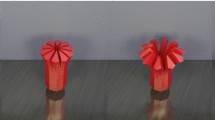Abstract
The cutting operation of 3D surface meshes plays an important role in surgery simulators. One of the important requirements for surgical simulators is the visual reality. We propose a new strategy for cutting on surface meshes: refinement and separate strategy consisting of the refinement followed by the separation of the refined mesh element.The proposed strategy gives the faithful representation of interaction paths of a surgical tool.
Preview
Unable to display preview. Download preview PDF.
Similar content being viewed by others
References
Cotin, S., Delingette, H., Ayache, N.: A hybrid elastic model for real-time cutting, deformations, and force feedback for surgery training and simulation. The Visual Computer 16(7), 437–452 (2000)
Bruyns, C.D., Senger, S.: Interactive cutting of 3d surface meshes. Computers & Graphics 25, 635–642 (2001)
Nienhuys, H.-W., van der Stappen, A.F.: A surgery simulation supporting cuts and finite element deformation. In: Niessen, W.J., Viergever, M.A. (eds.) MICCAI 2001. LNCS, vol. 2208, pp. 153–160. Springer, Heidelberg (2001)
Basdogan, C.: Simulation of instrument-tissue interactions and system integration, Medicine Meets Virtual Reality 2001 (2001)
Bielser, D., Glardon, P., Teschner, M., Gross, M.: A state machine for real-time cutting of tetrahedral meshes. Journal of Graphical Models 66(6), 398–417 (2004)
Harders, M., Steinemann, D., Gross, M., Székely, G.: A hybrid cutting approach for hysteroscopy simulation. In: Duncan, J.S., Gerig, G. (eds.) MICCAI 2005. LNCS, vol. 3750, pp. 567–574. Springer, Heidelberg (2005)
Ganovelli, F., Cignoni, P., Montani, C., Scopigno, R.: Enabling cuts on multiresolution representation. The Visual Computer 17(5), 274–286 (2001)
Mendoza, C., Laugier, C.: Simulating soft tissue cutting using finite element models. In: Proc. of the IEEE Int. Conf. on Robotics and Automation, Taipei, Taiwan, pp. 1109–1114 (2003)
Forest, C., Delingette, H., Ayache, N.: Removing tetrahedra from manifold tetrahedralisation: application to real-time surgical simulation. Medical Image Analysis 9(2), 113–122 (2005)
Rivara, M.-C.: New mathematical tools and techniques for the refinementand/or improvement of unstructured triangulations. In: 5th International Meshing Roundtable, pp. 77–86 (1996)
Bruyns, C., Senger, S., Menon, A., Montgomery, K., Wildermuth, S., Boyle, R.: A survey of interactive mesh-cutting techniques and a new method for implementing generalized interactive mesh cutting using virtual tools. Journal of Visualization and Computer Animation 13(1), 21–42 (2002)
Payandeh, S., Dill, J., Zhang, J.: A study of level-ofdetail in haptic rendering. ACM Transactions on Applied Perceptions 2(1), 15–34 (2005)
Tanaka, H.T., Kishino, F.: Adaptive mesh generation for surface reconstruction: Parallel hierarchical triangulation without discontinuities. In: Proc. IEEE Conf. Computer Vision Pattern Recognition (CVPR 1993), New York City, pp. 88–94 (1993)
Nienhuys, H.-W., van der Stappen, A.F.: Supporting cuts and finite element deformation in interactive surgery simulation, Tech Report
Liu, A., Tendick, F., Cleary, K., Kaufmann, C.: A survey of surgical simulation: applications, technology, and education. Presence: Teleoperators and Virtual Environments 12(6), 599–614 (2003)
Author information
Authors and Affiliations
Editor information
Editors and Affiliations
Rights and permissions
Copyright information
© 2006 Springer-Verlag Berlin Heidelberg
About this paper
Cite this paper
Viet, H.Q.H., Kamada, T., Tanaka, H.T. (2006). An Adaptive 3D Surface Mesh Cutting Operation. In: Perales, F.J., Fisher, R.B. (eds) Articulated Motion and Deformable Objects. AMDO 2006. Lecture Notes in Computer Science, vol 4069. Springer, Berlin, Heidelberg. https://doi.org/10.1007/11789239_38
Download citation
DOI: https://doi.org/10.1007/11789239_38
Publisher Name: Springer, Berlin, Heidelberg
Print ISBN: 978-3-540-36031-5
Online ISBN: 978-3-540-36032-2
eBook Packages: Computer ScienceComputer Science (R0)




